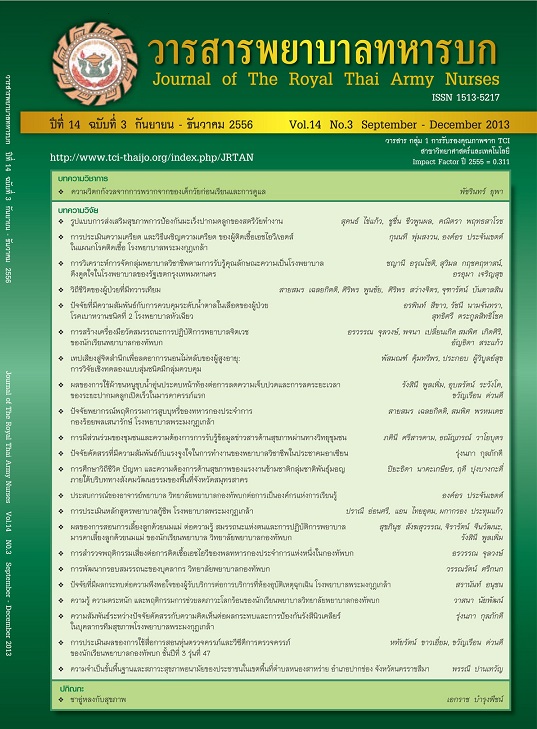รูปแบบการส่งเสริมสุขภาพการป้องกันมะเร็งปากมดลูกของสตรีวัยทำงาน Health Promoting Model of Cervix Cancer Prevention Among Working Women
Keywords:
รูปแบบการสร้างเสริมสุขภาพ, การป้องกันมะเร็งปากมดลูก, สตรีวัยทำงาน, health promoting model, pap’s smear, working womenAbstract
การวิจัยครั้งนี้มีวัตถุประสงค์เพื่อศึกษารูปแบบการส่งเสริมการป้องกันมะเร็งปากมดลูกของสตรีวัยทำงานในชุมชนแห่งหนึ่งเขตบางกอกน้อย กรุงเทพมหานคร โดยใช้กรอบแนวคิดของเพนเดอร์เลือกกลุ่มเป้าหมายแบบเฉพาะเจาะจง (purposive sampling) การวิจัยแบ่งเป็น 2 ระยะคือ ระยะ 1 ใช้การวิจัยเชิงปริมาณศึกษาหาผู้ที่มีพฤติกรรมเสี่ยงต่อการเกิดมะเร็งปากมดลูกเก็บรวบรวมข้อมูลโดยแบบสอบถาม ระยะที่ 2 เป็นการวิจัยเชิงปฏิบัติการแบบมีส่วนร่วม (PAR) โดยการทำสนทนากลุ่ม สัมภาษณ์ แบบเจาะลึก และใช้กระบวนการ AIC (Appreciation Influence Control) ร่วมกับการเยี่ยมบ้าน ประเมินความรู้และทัศนคติต่อการตรวจมะเร็งปากมดลูกด้วยแบบสอบถามก่อนและหลังการวิจัยเชิงปฏิบัติการผลการวิจัยพบว่าสตรีวัยทำงานที่เสี่ยงต่อการเป็นมะเร็งปากมดลูกทั้งหมด 220 ราย ส่วนใหญ่อยู่ในวัยกลางคน อาชีพรับจ้างรายวันรายได้ต่ำมีพฤติกรรมเสี่ยงต่อการเป็นมะเร็งปากมดลูกในระดับปานกลางและสูงมากกว่าร้อยละ 80 ไม่เคยตรวจมะเร็งปากมดลูกและไม่เคยตรวจสุขภาพประจำาปี ขาดความรู้เกี่ยวกับโรค มีทัศนคติที่ไม่ดีต่อการตรวจมะเร็งปากมดลูก ขาดปัจจัยสำคัญหลายประการเข้าไม่ถึงแหล่งให้บริการ ภายหลังกระบวนการกลุ่ม พบว่า กลุ่มเป้าหมายมีความรู้และทัศนคติดีขึ้น มากกว่าร้อยละ 80 กระตือรือร้นไปตรวจมะเร็งปากมดลูกเพราะตระหนัก มองเห็นความสำคัญ และประโยชน์การป้องกันโรค กลุ่มมีการกำหนดนัดเพื่อตรวจซ้ำในครั้งต่อไปซึ่งแสดงถึงความยั่งยืนของโครงการ สรุปรูปแบบการส่งเสริมการป้องกันมะเร็งปากมดลูกสำหรับสตรีวัยทำงานกลุ่มนี้ ได้แก่ การให้ความรู้ความตระหนักในความรุนแรงของโรคและประโยชน์ของการป้องกันโดยกระบวนการกลุ่มและกระบวนการ AIC ที่ทุกคนร่วมเรียนรู้มีส่วนร่วม
ในการมองปัญหาอุปสรรค การแก้ไขปัญหาและการประเมินผล การสร้างเครือข่ายความต้องการอำนวยความสะดวกในการตรวจมะเร็งปากมดลูกแบบกลุ่ม และติดตามแจ้งผลให้ทราบ มีระบบการประสานงานโดยภาคส่วนที่เกี่ยวข้องทุกระดับที่มีการสานสัมพันธ์เป็นอันดี (mutual collaboration)
ข้อเสนอแนะ ควรใช้รูปแบบนี้อย่างต่อเนื่องเพื่อการคงพฤติกรรมการป้องกันมะเร็งปากมดลูกในกลุ่มสตรีวัยทำงานของชุมชนลักษณะนี้ไว้ได้อย่างยั่งยืน
This participatory action research was aimed to study health behavior promoting model for cervix cancer prevention among working women by applying Pender’s conceptual framework (1996). The 2 phases research were used. In the first phase, risk health behaviors was studied by questionnaires. For the second phase, the Participaty Action Research (PAR) was used as focus group in depth interviews and AIC (Appreciation
Influence Control) including home visit. Cervix cancer assessment knowledge and attitude detection before and after PAR by questionnaires. This research process was based on mutual approach among the researchers,community volunteer leaders and working women.
The results revealed that the 220 women with moderate and high risk behavior were selected by purposive sampling. The almost of them were in middle age with low socio-economy, never has pap’s smear nor yearly health assessment caused by lack of knowledge, can not access pap’s smear service, and poor attitude. At the end of study, more than 80% had increased knowledge and improved attitude on cervix cancer examination. Furthermore, there was commitment to set an appointment for the next pap’s smear together.
In conclusion, the successful strategies for promoting health behavior among these working women were establishing mutual collaborative participation, forming peer group learning, home visiting education,
repeated health education, providing encouragement, and supporting health care facilitating system to access for them. Therefore, heath care team need to strengthen their roles in health education, coordination and
appropriate referring to health care institute for further management.
Downloads
Downloads
How to Cite
Issue
Section
License
บทความหรือข้อคิดเห็นใดใดที่ปรากฏในวารสารพยาบาลทหารบกเป็นวรรณกรรมของผู้เขียน ซึ่งบรรณาธิการหรือสมาคมพยาบาลทหารบก ไม่จำเป็นต้องเห็นด้วย
บทความที่ได้รับการตีพิมพ์เป็นลิขสิทธิ์ของวารสารพยาบาลทหารบก
The ideas and opinions expressed in the Journal of The Royal Thai Army Nurses are those of the authors and not necessarily those
of the editor or Royal Thai Army Nurses Association.






